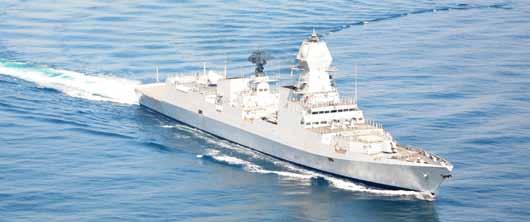
6 minute read
Indian Navy sails closer to indigenisation target
Admiral Karambir Singh
PVSM, AVSM, ADC Chief of Indian Navy
Advertisement
The year 2020 was marked by a series of glorious moments for the Indian Navy, most of which took the nation nearer to the goal of Atmanirbhar Bharat, or self-reliance, in defence. Notable achievements during the year were the commissioning of several ships and the firstever arrested landing of the Naval version of the Light Combat Aircraft on an aircraft carrier, among others. Other major engagements that kept the Indian Navy busy included a number of joint exercises and Passex with friendly Navies. Moreover, the Indian Navy tackled the threat posed by the pandemic effectively.
The Indian Navy (IN) guards the nation’s maritime borders and also protects its various ocean-related interests. As part of its call of duty, IN’s operational deployments during 2020 included Operation Sankalp, Operation Samudra Setu, Mission Sagar and Sagar-II.
Amidst the increasing US – Iran tensions in the Gulf region since June 2019, IN has been undertaking a maritime security operation codenamed Op Sankalp in the area to ensure safe passage of Indian Flag Merchant Vessels (IFMVs) transiting through the Strait of Hormuz. Since then, IN has deployed 16 warships and escorted around 161 lakh tonnes of cargo onboard 156 IFMVs.
Indian Navy ships Jalashwa, Shardul, Airavat and Magar were deployed from May to July for Operation Samudra Setu to undertake repatriation of stranded Indian nationals in the wake of COVID-19 from Iran, Maldives and Sri Lanka. The Navy ships deployed for Op Samudra Setu evacuated 3,992 Indian nationals.
INS Kesari was deployed to the Southern IOR (Indian Ocean Region) island nations as part of Mission Sagar for rendering COVID-19-related assistance from May-June. During deployment, the ship provided medicine stores and medical kits to Maldives, Mauritius, Madagascar, Comoros and Seychelles. As part of the follow-up Mission Sagar II, INS Airavat was deployed to deliver humanitarian aid stores to Djibouti, Massawa (Eritrea), Port Sudan and Mombasa, Kenya (for South Sudan) from October-November.
Exercises with foreign Navies
The Indian Navy and Royal Navy of Oman (RNO) conducted a bilateral exercise Naseem-Al-Bahr at and/ off Goa. RNO ships Al Rasikh and Al Khassab along with IN ships Beas and Subhadra participated in the exercise. Moreover, IN and Russian Federation Navy (RuFN) carried out a bilateral exercise named ‘Indra Navy’ in the Bay of Bengal during September. RuFN ships Admiral Tributs, Admiral Vinogrodov, Boris Butoma and IN ships Ranvijay, Kiltan and Shakti participated in the exercise.
IN and JMSDF (Japan Maritime Self Defence Force) engaged in a bilateral exercise titled JIMEX 2020 in the Arabian Sea during September. JMSDF ships Kaga and Ikazuchi; IN ships Chennai, Tarkash and Deepak, IN aircraft P8I, MIG 29K and integral helicopters of both navies participated.
Bongo Sagar 2020, the bilateral exercise involving IN and Bangladesh Navy (BN), was held in North Bay of Bengal in October. IN and Sri Lanka Navy (SLN) joined for the bilateral exercise Slinex 2020 in the Bay of Bengal. Maiden landing of Advanced Landing Helicopter (ALH) was undertaken onboard SLN Ship Gajabahu during the exercise, to showcase IN’s indigenous capability.
Malabar 2020, the multilateral exercise between IN, US Navy (USN), JMSDF and Royal Australian Navy (RAN) ships, was conducted in the IOR in November. Similarly, the multilateral exercise between IN, Republic of Singapore Navy (RSN) and Royal Thailand Navy (RTN) took place in the Eastern IOR during November. IN and RSN also carried out the bilateral exercise Simbex 2020 in Eastern IOR.
Passex
The Indian Navy undertakes Passage Exercise (Passex) with friendly foreign Navies on suitable occasions to enhance
inter-operability and imbibe best practices. Following Passex took place in 2020: Passex between French Naval ships Mistral and Geupratte and IN Ships Talwar and Trikand in the Gulf of Aden in May; between JMSDF training ships Kashima and Shimayuki and IN ships Rana, Kulish in Eastern IOR; USN ships Nimitz, Princeton, Ralph Johnson, Sterett and IN Ships Rana, Sahyadri, Shivalik, Kamorta engaged in a Passex in the Bay of Bengal; between Australian ship HMAS Toowoomba and IN Ship Kochi; and involving Australian ship HMAS Hobart and IN ships Sahyadri and Karmuk in Eastern IOR.
CORPAT
Coordinated Patrol (CORPAT) with Indian Ocean Region Littoral Navies is also part of IN’s tasks. As part of maritime security cooperation with maritime neighbours, Coordinated Patrols along the International Maritime Boundary Line (IMBL) are conducted with Indonesia, Thailand, Bangladesh and Myanmar.
Anti-piracy patrol
To address the unconventional security challenges in the maritime domain such as piracy, smuggling, human trafficking and gun-running, IN has been deploying a ship in the Gulf of Aden since 2008 and a total of 84 ships have been engaged in this task till now.
EEZ surveillance
As part of Exclusive Economic Zone (EEZ) Surveillance, IN is committed to assisting friendly IOR littoral nations in maritime surveillance. Accordingly, IN regularly undertakes surveillance of the EEZ of Maldives once a month, and of Seychelles and Mauritius twice a year.
Commissioning / work launch
Numerous ships and other vessels were commissioned and production launched during the year. Notable among them was INS Kavaratti, the fourth and last ship of Project 28, commissioned on October 22 at Visakhapatnam and IN LCU L57 commissioned at Port Blair in May.
Similarly, the keel-laying ceremony of Yard 3023 (Second ship of Project 17A at GRSE) was held in January at GRSE, Kolkata and that of Yard 12653 (Third ship of Project 17A at MDL) was held on September 10, at MDL, Mumbai.
Production of Yard 12654 (fourth ship of Project 17A at MDL ) commenced on January 22 at MDL, Mumbai and that of Yard 3024 (third ship of Project 17A at GRSE) began at GRSE, Kolkata in August.
Innovation, Indigenisation
Introduction of Higher Specs Fuel for IN ships (LSHFHSD – IN 512) was a significant achievement in 2020. Supply of the new fuel through IOCL commenced in March and the initiative would go a long way in enhancing equipment reliability and performance along with reduced carbon footprint and emissions.
Moreover, in order to meet global protocols, IN has migrated from Halon-based fire-fighting (FF) system and CO2-based FF system to environmentally-benign new generation FF system for onboard application.
IN continues to be at the forefront of indigenisation, in-line with the Government’s vision for ‘Atmanirbhar Bharat’. Out of 43 ships on order, 41 are being built indigenously and Acceptance of Necessity (AoN) exists for construction of 44 ships and submarines to be built indigenously. IN has developed 23 major equipment/systems and over 4,500 subassemblies/components indigenously for IN ships and submarines. Moreover, the first commercial supply of indigenously designed and developed Sonar Dome for IN ships was done by Kineco, Goa.
Efforts during COVID-19
Various innovative solutions were worked out by IN yards, including Multi-Feed Oxygen Manifold, portable Non-Contact Thermometer, UV sterilization chamber for sanitization of tools and uniforms and development of foot-pedal operated cleansing stations. An innovative personal protective equipment (PPE) was developed by the Innovation Cell at the Institute of Naval Medicine in collaboration with the Naval Dockyard, Mumbai.
Other major feats
In keeping with the vision of Atmanirbhar Bharat, the Naval Innovation and Indigenisation Organisation (NIIO) was inaugurated by the Defence Minister in August. Indian Navy signed four MoUs with Uttar Pradesh Expressway Industrial Development Authority, Raksha Shakti University at Gujarat, Maker Village at Kochi and the Society of Indian Defence Manufacturers to interact with academia and industry on self-reliance. In addition, IN’s indigenisation plan titled ‘Swavlamban’ was also released by the Defence Minister.
Another event was the hydrographic survey team participating in the 39th Indian Scientific Expedition to Antarctica from December 2019 to May 2020.
Finally, the Light Combat Aircraft (Navy) jointly developed by ADA (Aeronautical Development Agency) and IN achieved a major milestone when the aircraft undertook the first-ever arrested landing on an aircraft carrier.











